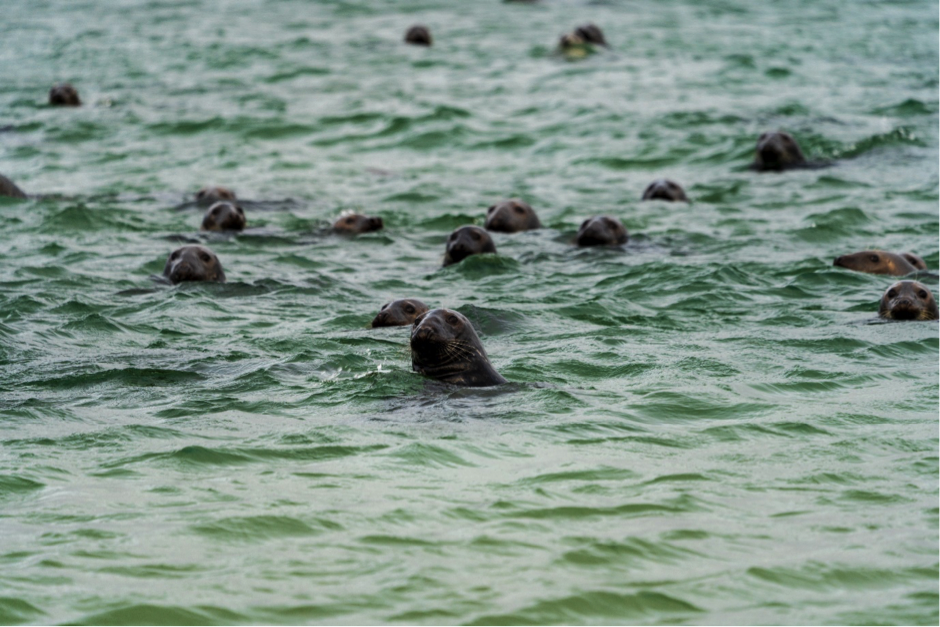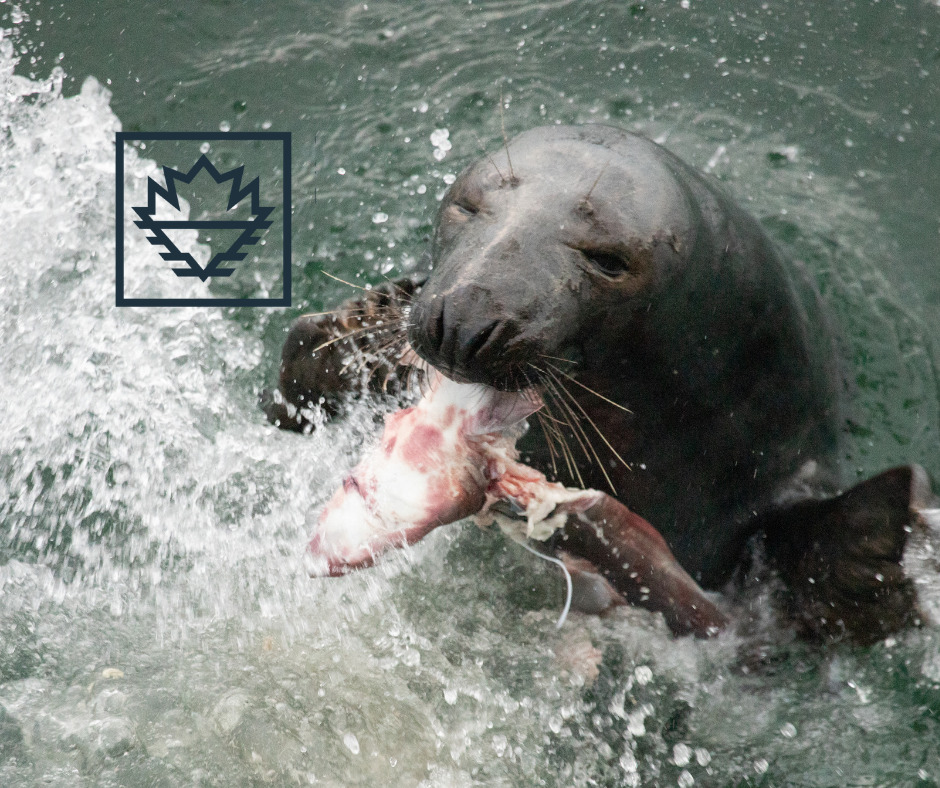Why Seal Populations Must Be Managed
Canada is home to six species of seal – harp, grey, ringed, harbour, hooded and bearded – thought to total over 10 million. These seal populations, all of them healthy and growing, play a major role in the marine ecosystem, but how they should be managed is controversial.
The fishing industry in particular wants immediate action to reduce seal numbers, but the Department of Fisheries and Oceans (DFO), citing a lack of science, prefers a cautious approach to the point where there is almost no management at all. If the status quo is maintained, everyone could lose – including the seals.

Abundant Populations
Of those six species, harp and grey seals are the biggest competitors of commercial fishing and therefore the most controversial.
The world’s largest population of harp seals is in the Northwest Atlantic, comprised of three herds. The Front herd breeds off Labrador and Newfoundland; the Gulf herd breeds near the Magdalen Islands; and a smaller herd breeds in the north of the Gulf of St. Lawrence. The total Northwest Atlantic population is estimated at 7.4 million (source), and is believed to be growing. But how it compares with historic levels is disputed.
Like harp seals, grey seals are found on both sides of the Atlantic. Until a few decades ago, the western stock was largely confined to Atlantic Canada, particularly in the Gulf and off Newfoundland, the Maritimes and Quebec. Now its range is expanding southwards to areas where it was formerly extirpated, and it is already numerous in New England. The Canadian population is estimated at 505,000 (Source).

Competition with Fishing Industry
Atlantic Canada’s commercial fish stocks have been in trouble for decades. In 1992 a moratorium was put on northern cod fishing off Newfoundland – once the largest cod fishery in the world. Stocks now seem to be recovering, but it’s taken a lot longer than expected. Capelin, herring and mackerel are all down, and Atlantic salmon are at an all-time low.
Meanwhile, harp and grey seal populations have been growing, and eating more and more of what fish are left.
To the fishing industry, it seems obvious that seal numbers must be reduced, but the DFO urges caution, citing big gaps in our scientific knowledge of the relationships between harp seals and fish stocks.
Mutliple studies of grey seals have been done, and the indications are that they are hurting fish stocks and slowing the recovery of cod and other fish species. This comes as no surprise to the fishing industry. What is surprising is that the DFO insists that grey seals and harp seals are different, and more studies on harp seals are needed. And its findings on harp seals, such as they are, have been controversial.

For example, in 2008, the DFO found that harp seals were not a significant factor in the slow recovery of cod, and were not hurting capelin stocks. And in 2011, a review commissioned by the DFO found “little evidence that seal predation was having a major impact on most commercial fish stocks.”
Fishermen, though, prefer to trust their own eyes, and what they see does not support what the DFO says. Last May, for example, video taken from a fishing boat (source) showed so many harp seals it looked like the sea was boiling!
In the meantime, the sealing industry – the only real check on seal numbers endorsed by the DFO – has been having trouble meeting its quotas. Climate change has seen the ice floes on which harp seals haul out retreating, making the seals less accessible. In 2019, sealers harvested less than 10% of their total allowable catch. In 2020, there was no harvest at all due to Covid-19, and there were around 30,000 seals harvest in March 2021.
So How Much Fish Are They Eating?
How much fish seals actually eat is just one area of scientific uncertainty, but it must be a lot.
On the low side, a study in the Barents Sea estimated the average harp seal eats between 1.2 and 1.8 metric tons/year (source). On the high side, another study of harp seals by Polar Research, also in Europe, estimated 7.4 kg/day for adult males and 9 kg/day for adult females (source), with females consuming more to support pregnancy and lactation. Assuming the population is half male and half female, that means an average seal eats 2.99 tons/year.
This means the 7.4 million seals in Atlantic Canada eat up to 22 million tons/year.
To put this in context, in 2019 the Atlantic Canada fishing fleet landed a total of 560,484 tons (source). So Canada’s harp seals alone are eating up to 40 times as much seafood as fishermen catch (7).

Multispecies Management Is Complex but Vital
Wildlife management today strives to be as holistic as possible. Historically, the focus tended to be on individual species, and even now, if a species is endangered, that still happens. But in the case of ecosystems like our oceans, multispecies management is almost always preferred.
However, it is very complex, and often involves guesswork.
Take, for example, the relationship among cod, capelin, the fishing industry and seals (while trying to factor in everything else like climate change, pollution, etc.). Despite a moratorium on cod fishing, the stock’s recovery has been slow, and since cod eat capelin, it was thought there might not be enough capelin for the cod to eat, so fishing quotas for capelin were reduced. But when the cod recovery didn’t seem to be happening, it was proposed that the capelin were eating so many cod fry that the cod were not reaching reproductive age. So were there too few capelin or too many?
Meanwhile, as autopsies have repeatedly shown, seals eat capelin – and cod, when available. And seal numbers are increasing. Could it be that one reason cod are taking so long to recover is because there are too many seals? The fishing industry certainly thinks so and several DFO studies conducted on other species of fish tend to prove it as well:
- Cod: “Predation by grey seals appears to currently be the main cause of this mortality.”
- Lumpfish: “Marine mammals are known predators of the lumpfish.”
- American Plaice: “A likely reason for the increased natural mortality is predation by grey seals (Swain and Benoît 2015).”
- Winter Flounder: “The causes of the high natural mortality are not fully known but available evidence supports the hypothesis that predation by grey seals is a major component of this increased natural mortality.”
- White Hake: “Predation by seals in Newfoundland waters may contribute to low levels of White Hake abundance, but studies using larger sample sizes (as compared to Hammill et al. 2007) are necessary to quantify any effects of seal predation on White Hake abundance in Div. 3P. /…/ In the Gulf of St. Lawrence, White Hake constitutes a large part of the diet of both Grey Seals (Halichoerus grypus) and Harp Seals (Phoca groenlandica; Hammill and Stenson 2002; Hammill et al. 2014).”
- Winter Skate: “Predators of adult Winter Skate include Grey Seal and large sharks. Most large sharks (e.g., Porbeagle) are estimated to have declined on the ESS (DFO 2015) and thus predation by sharks is unlikely to represent an important component of increased M of adult Winter Skate.”
- Yellow Tale Flounder: “Predation by grey seals appears to be an important cause of this elevated mortality (e.g. Swain and Benoît 2015; Neuenhoff et al. 2019).”
Rising Shark Attacks
Another consequence of rising seal numbers has been an increase in shark attacks off New England (source).
All seals have been protected in the US since 1972, under the Marine Mammal Protection Act, and today New England and points south have growing populations of grey and harbour seals reclaiming their former ranges. Meanwhile, starting in 1997, white sharks have had federal and state protection.
So the seals and sharks are rebounding, which sounds great. But there’s a downside.
New England’s beaches make tourism an important part of the local economy. But increasingly, swimmers and surfers must share the water with seals, a favourite snack of sharks. Which means more interactions between humans and sharks.
Shark attacks on humans are rare, but they’re on the rise here, and sometimes fatal. Two recent deaths were Julie Dimperio Holowach in 2020, off Maine (source), and Arthur Medici in 2018, off Cape Cod (source).
Shark attacks also hurt tourism in general. If you’ve seen the movie Jaws, filmed in New England, you’ll know how this works.
And If Seal Populations Are Not Managed?
If Canada’s harp and grey seal populations continue to grow unchecked, there will be consequences, some of which are already being felt. In the view of the fishing industry at least, seals are hurting commercial fish stocks. And shark sightings off New England are on the rise. So what other scenarios might unfold?
Harp seals are probably already facing limiting factors to their growth. At some point there may not be enough food to support more seals, and while restricting commercial fishing still further could delay this, it would only be a band aid. If this happens, nature will step in with remedies like starvation and disease. Another limiting factor to growth could be climate change. If the ice floes on which harp seals breed continue to retreat, this could lower the seals’ reproduction rate, or cause them to relocate beyond the reach of sealers, which in turn would have consequences for local economies.
Grey seals, meanwhile, appear to have a safety net for now which involves expanding their range southwards. This is already causing conflicts with fishermen off New England, plus of course there are those shark attacks. These conflicts are sure to rise, as will calls to amend the Marine Mammal Protection Act to allow a cull of grey seals.
All this uncertainty can be minimised, however, if efforts are stepped up now to balance the interests of the fishing industry with the health of seal populations. For the moment, only the fishing industry is being managed, while seals go largely unchecked, and this does not bode well for the future.
Sources:
- https://www.dfo-mpo.gc.ca/fisheries-peches/seals-phoques/species-especes/index-eng.html
- https://www.dfo-mpo.gc.ca/species-especes/profiles-profils/harpseal-phoquegroenland-eng.html
- http://canadiansealproducts.ficwebhosting.com/the-canadian-seal/sustainability/the-seal
- https://www.dfo-mpo.gc.ca/csas-sccs/Publications/SAR-AS/2014/2014_010-eng.html
- https://www.saltwire.com/atlantic-canada/business/5-miles-of-seals-newfoundland-fishermans-video-goes-viral-fires-up-more-debate-about-pinnipeds-100597203/#
- https://www.researchgate.net/publication/284675201_Food_consumption_estimates_of_Barents_Sea_harp_seals
- https://www.tandfonline.com/doi/pdf/10.3402/polar.v10i2.6771: “Present estimates indicate average maintenance requirements of about 13,600 and ll,150kcal/day for adult female and male harp seals respectively. The high value for the females is due to the costs of pregnancy and lactation. With a mean energy density of prey of 1500 kcal/kg, the corresponding food consumption is 9 kg/day for females and 7.4 kg/day for males.” Calculation: (7.4+9)/2 = average of 8.2KG per seal. 8.2*365 days per year = 2,993KG. 2,993KG x 7.4 million harp seals = 22,148,200,000. 22,148,200,000 (total KG of fish eaten by harp seals)/ 560,000,000 (harvested by the Atlantic fishing fleet in 2019)= 39.55 TIMES
- https://www.dfo-mpo.gc.ca/stats/commercial/land-debarq/sea-maritimes/s2019aq-eng.htm
- https://waves-vagues.dfo-mpo.gc.ca/Library/40805542.pdf
- https://waves-vagues.dfo-mpo.gc.ca/Library/365597.pdf
- https://waves-vagues.dfo-mpo.gc.ca/Library/40594105.pdf
- https://waves-vagues.dfo-mpo.gc.ca/Library/40619278.pdf
- https://waves-vagues.dfo-mpo.gc.ca/Library/365470.pdf
- https://waves-vagues.dfo-mpo.gc.ca/Library/40614153.pdf
- https://www.dfo-mpo.gc.ca/csas-sccs/Publications/SAR-AS/2021/2021_022-eng.pdf
- https://www.wbur.org/news/2020/07/30/seal-increase-shark-attack-sightings-maine-cape-cod
- https://fox23maine.com/news/local/one-year-later-changes-made-after-deadly-shark-attack-in-harpswell
- https://www.bostonmagazine.com/news/2019/05/14/cape-cod-sharks/



